The Battle of Pavia on tapestries by Bernard van Orley
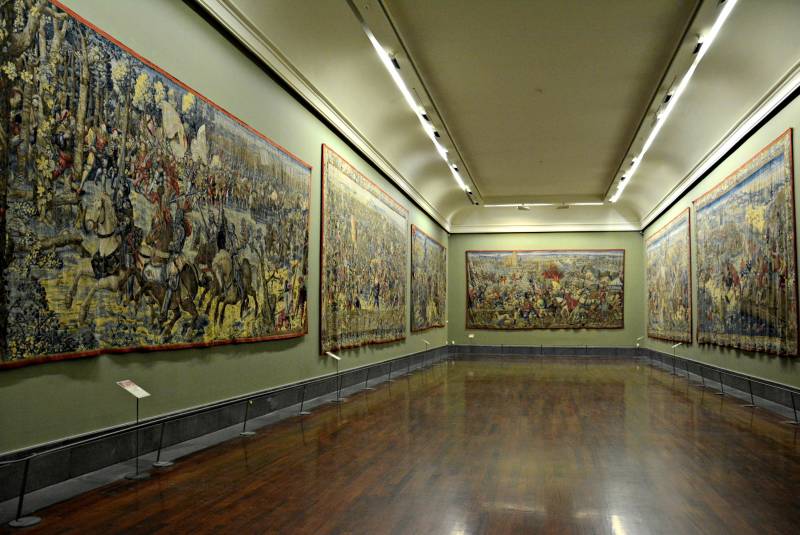
A room with tapestries depicting scenes from the Battle of Pavia. National Museum of Capodimonte, Naples, Italy
The great Pompey lost the battle of Pharsalus,
and King Francis the First, who I heard
also cost something - the battle of Pavia.
A. Dumas "Three Musketeers"
History in artifacts. We have already referred here more than once to embroideries and tapestries, which are of interest from the point of view of the study of history. According to the time scale, we went “from the bottom up”, that is, starting with the “Bayesian embroidery”, but later a lot of embroidered images were made, sometimes with photographic accuracy conveying the realities of their era.
These include seven tapestries woven in Brussels in 1528-1531, based on sketches by Bernard van Orley. Their value, in addition to beauty, lies in the fact that they illustrate for us in detail the scenes of the battle of Pavia. And this battle was very important in all respects, since it took place at the turn of the epochs. In it, the traditional cavalry of the gendarmes collided with armed firearms. weapons infantry and suffered a crushing defeat from it.
Naturally, today we cannot travel back to the beginning of the XNUMXth century and see how it happened with our own eyes. But we can try to imagine it by looking at the beautiful tapestries of Bernard van Orley.
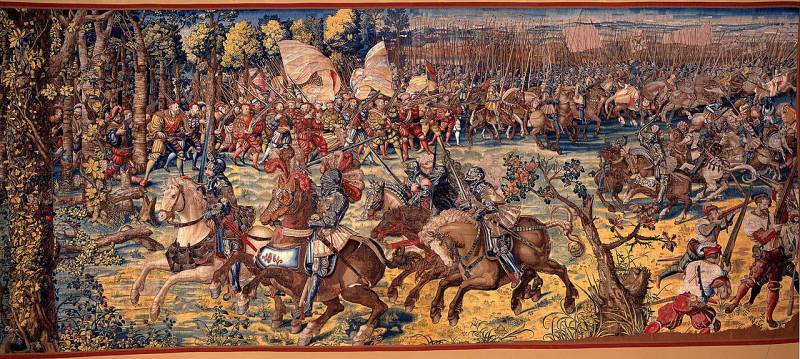
Tapestry 1. It shows the attack of the French gendarmes led by King Francis I. In the distance, against the background of the forest, German arquebusiers are visible, preparing to open fire on the French cavalry. The equipment of the gendarmes attracts attention. They wear full knightly armor with characteristic cloth skirts instead of legguards. On the tapestry, armor on many horses is missing. One horse has a breastplate and saffron, the other has a saffron and collar, but such details as caps and flanshards are missing. By the way, since they are all with swords in their hands, this means that they have already lost their spears in the previous battle.
So, the battle of Pavia, which happened on the morning of February 24, 1525, became the main and decisive battle of the Italian War of 1521-1526. between the French kingdom and the multinational empire of Charles V, who, as Holy Roman Emperor, was at the same time king of Spain, "both Indies", and also ruled the Netherlands and, in addition, the Two Sicilies.
The French army was under the command of the King of France, Francis I, who in October 1524 laid siege to the city of Pavia, which was part of the Duchy of Milan as part of the Holy Roman Empire, having 26 soldiers in his army, among whom were many mercenaries. French proper 200 infantry and 6 foreign mercenaries: 000 Swiss, 17 Germans and 000 Italians ("Black Stripes"). The striking force of the French army was a plate cavalry of 8 gendarmes and 000 spearmen.
Charles V intended to lift the siege from the city, and sent an army of 22 soldiers to Pavia. Moreover, in the city itself there was an imperial garrison of 300 Germans and 5 Spaniards. The imperial forces were commanded by the Fleming Charles de Lannoy, imperial lieutenant and viceroy of Naples, and the French renegade defector, Captain General Charles III, Duke of Bourbon. Under their command were 000 German landsknechts, 1 Spanish and 000 Italian soldiers, commanded by the Italian condottiere, the Marquis of Pescara, along with the German commander Georg Frundsberg. The Spanish captain Antonio de Leyva commanded the garrison of the besieged Pavia. The imperial cavalry numbered 12 knights and 000 lancers.
The battle took place in the Visconti Park in Mirabello di Pavia, right next to the city walls. King Francis I, having shown considerable courage, and in the best traditions of the medieval war, personally led his gendarmes against Lannoy, but the German and Spanish spearmen and arquebusiers managed to repel it, after which Spanish and German infantrymen fell upon them from all sides, who began to exterminate the mounted gendarmes with fire from arquebus and muskets.
The remnants of the French forces, including the Swiss mercenaries and the "Black Bands", made a courageous attempt to protect the king, but were eventually surrounded by enemy spearmen and also defeated. In addition, the garrison of Pavia made a sally. And it turned out that in the course of a four-hour battle, the French army was defeated in parts. Many noble nobles of France were killed, and Francis I himself, narrowly escaping death, was captured.

Tapestry 2. On the left, the Spanish arquebusiers, led by the Marquis di Pescara, attack the French gendarmes. Clouds of smoke from arquebus shots are clearly visible. On the right, the landsknechts of Georg von Frundsberg capture the French battery
Captured by Charles V, Francis I had to sign the Treaty of Madrid in 1526, renouncing his claims in exchange for the desired freedom.
The beginning of this whole dramatic story was laid first of all by Francis I himself, who in mid-October 1524 crossed the Alps and moved to Milan, with an army of more than 40 people. The troops of Bourbon and Pescara, numerically inferior to him, could not offer serious resistance and began to withdraw. The French army advanced in several columns at once, preventing the imperials from holding back their advance, but it also failed to call them to battle.
Francis entered Milan, appointed him governor of Louis II de la Tremoulle, but further, although he was advised to continue the pursuit of Lannoy, laid siege to the city of Pavia, where there was an imperial garrison of about 9 people, consisting of mercenaries who had to be paid by melting church silver . On November 000, Francis, having broken through the gaps in the walls of the city by this time, decided to storm the city, but his troops were driven back with heavy losses. Then the French decided to starve his defenders to death.
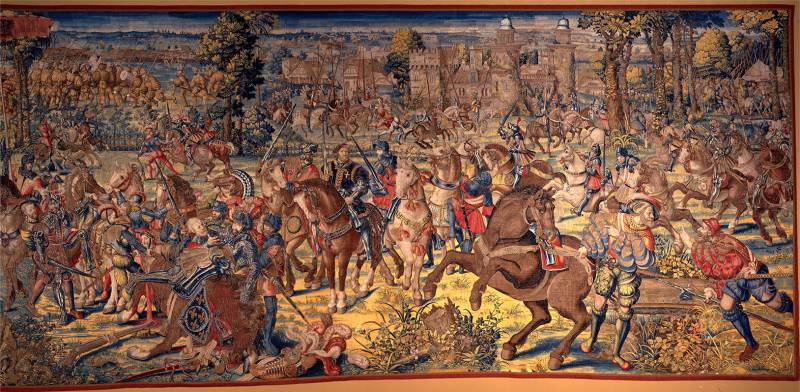
Tapestry 3. On the left, King Francis I is shown being dragged from his horse. Whether this was actually the case, or whether he fell from his horse and was captured by the already lying one, is unknown. But the artist saw it that way. On the right, a German landsknecht has captured an important trophy - a horse, and explains to another landsknecht that now, they say, this horse is mine!
In general, things at the front of the French king seemed to be going well. So, he managed to sign a secret agreement with Pope Clement VII that he would not help Charles, and Francis would help him conquer Naples, where he had to send part of his soldiers. Lannoy's attempt to intercept them failed, and moreover, in the battle with the royal troops, he suffered heavy losses.
On the side of the French, the “Black Gangs” of Giovanni Medici, Italian mercenaries who switched to the French service, acted very effectively. However, the number of French troops at Pavia was reduced by the departure of almost 5 Swiss mercenaries, who were ordered to return to Switzerland to protect their own borders. Then already in January 000, Georg Frundsberg brought Lannoy 1525 fresh German landsknechts, and with these forces they resumed their attacks on the French.
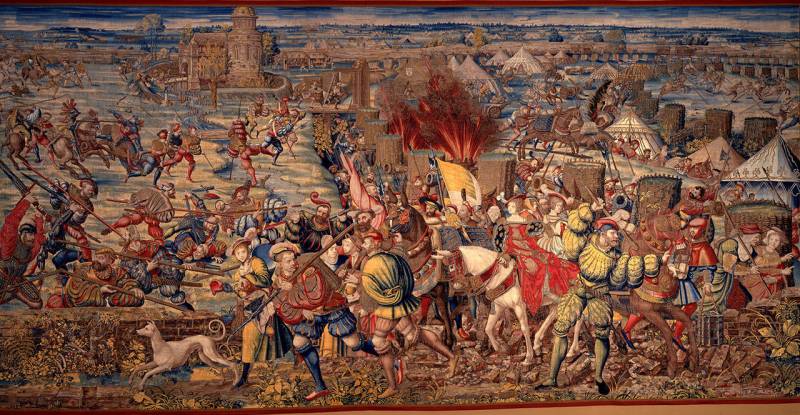
Tapestry 4. On the left, the landsknechts of Georg von Frundsberg are fighting with the landsknechts of King Francis I. In the distance, one of the landsknechts jumps over the stream, leaning on his pike, like a scout. Interestingly, there are quite a few women in this picture, and one of them is on horseback and in a side saddle. Who are they? Canteens or regimental whores? It is impossible to say, but they are dressed, especially the "lady in red", not poorly. But boxes and chests bound with metal strips clearly replace suitcases. The civilians are seen fleeing towards the river
Already on February 2, Lannoy was only a few miles from Pavia, so that Francis had to act on two fronts: against the defenders of the city and the approaching imperial army. However, it seemed to the imperials that the forces of the French were much superior to them, so that although they intended to give them battle, they did not particularly count on victory.
Moreover, on the evening of February 23, they set fire to their tents in order to make the French believe that they had begun to withdraw from the city. In fact, in the early morning they made several breaches (they did not use gunpowder, but worked as a trench tool!) In the walls surrounding the huge Mirabello Park, where the French troops were stationed, and under the cover of twilight and fog they began to enter it - first arquebusiers, and after them light cavalry and artillery. The target of the attack was the castle of Mirabello, where, as the Spaniards believed, the headquarters of the French army was located.
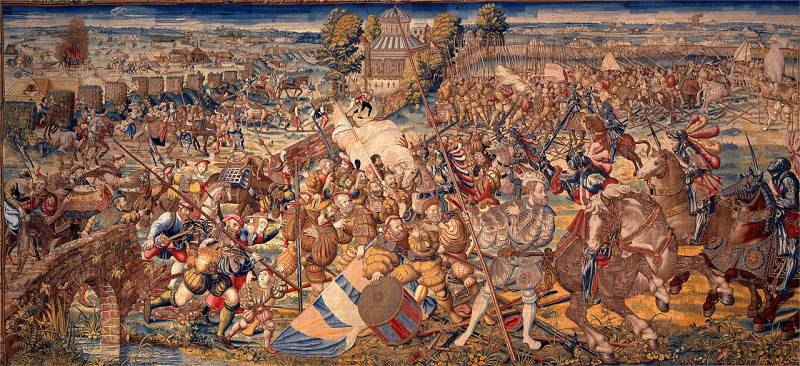
Tapestry 5. On the right, French gendarmes trying to attack the imperial landsknechts with two-handed swords and pikes in their hands, who penetrate Mirabello Park through breaches in the wall. Surprisingly, together with them we see a priest with a shaved tonsure and even a mule, on which a monkey rides on a chain!
Noticing the movement of the Imperials, French troops came out to meet them. By 7 o'clock in the morning, a large-scale infantry battle was unfolding in the park with the participation of landsknechts of Georg Frundsberg, Spanish arquebusiers, French spearmen and landsknecht defectors from the "Black Squad" under the command of Francois from Lorraine, who fought on the side of the French. Numerous French artillery also opened fire, causing serious damage to the imperial infantry.
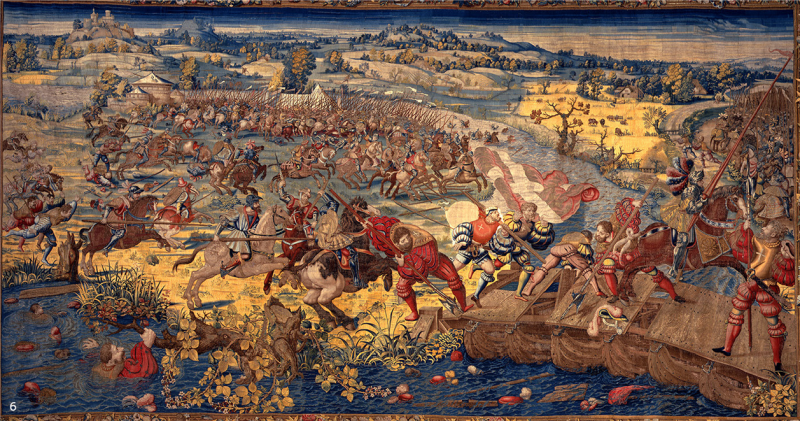
Tapestry 6. The French army flees from the battlefield, and landsknechts destroy the floating bridge with their halberds ...
Interestingly, the French did not realize for some time the true extent of the imperial attack; however, by about 7:20 a.m., masses of imperial cavalry were seen advancing behind the infantry from a battery of French artillery. Artillery fire was opened on the enemy, which began to inflict losses on him, but the appearance of the enemy cavalry alerted Francis, who decided to attack it with all the forces of the French gendarmes.
Initially, his attack was successful, and by 7:40 a.m. Lannoy's imperial horsemen were dispersed. However, the rapid advance of Francis not only weakened the fire of the French artillery, but also tore off his gendarmes from the mass of French infantry under the command of Richard de la Pole and the "Black Squad" of renegade landsknechts.
The Marquis of Pescara, who remained in command of the Spanish troops after Lannoy left the battlefield along with the retreating cavalry, quickly formed his men at the edge of the forest and immediately sent messengers to other commanders asking for help. And just at this time, the landsknechts of Frundsberg managed to defeat the Swiss infantry opposing him, which led the French infantry into such confusion that they began to leave the battlefield.
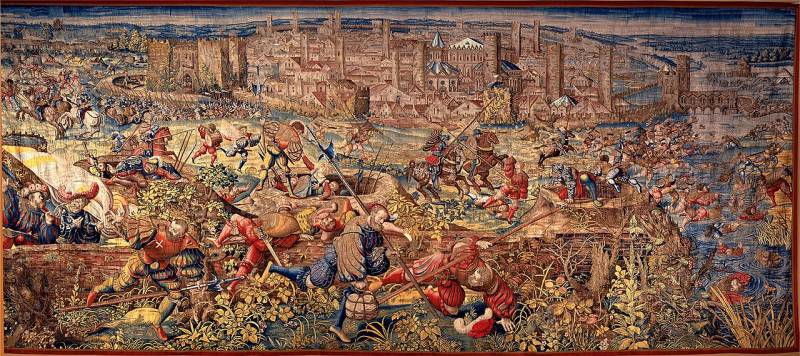
Tapestry 7. Sally of the garrison of Pavia. The French crawl out of their fortifications and try to swim across the river to escape. Both the attire and the weapons of the Landsknechts are depicted very accurately - their halberds and Kalzbager swords.
Already at 8 o'clock in the morning the French cavalry was surrounded by a mass of imperial pikemen and arquebusiers. With no room to maneuver due to the fact that there was a forest nearby, the French gendarmes became easy prey for the shooters.
Meanwhile, in a fierce battle between the imperial landsknechts and the Black Detachment, the latter was surrounded by Frundsberg spearmen and completely destroyed. The French king was fighting with his gendarmes when Cesare Hercolani, an Italian condottiere, killed his horse under him and, surrounded by Spanish arquebusiers and German landsknechts, he was captured and led out of the battlefield.
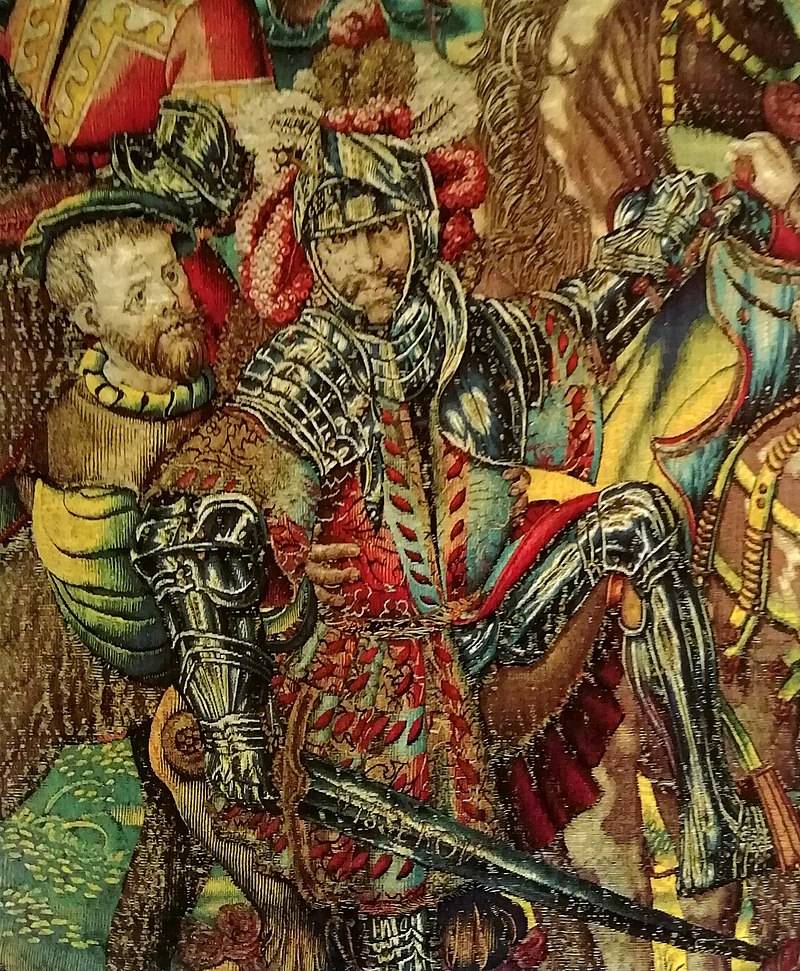
And now consider some fragments of the tapestry when enlarged. On it, as it turned out, there are a lot of accurately executed images of specific participants in the battle. This is Charles de Lannoy - the commander of the imperial troops
At the same time, the landsknechts of Antonio de Leyva made a sortie from the city and defeated 3 Swiss who occupied the siege trenches. The remnants of the Swiss tried to escape across the bridge over the river, but after it was destroyed, they had to swim for their lives, as a result of which they suffered huge losses in the process.
The French rearguard under the command of the Duke of Alençon did not take part in the battle, but when the Duke realized what had happened in the park, he ordered to retreat towards Milan. By 9:00 the battle ended with the complete defeat of the French army.
By the way, who exactly took the French king prisoner is still not clear, since historians put forward many candidates for this role. First of all, this is Charles de Lannoy himself, who made the king his prisoner after, supposedly out of respect, kneeling before him. According to this version, Lannoy and Francis I exchanged swords.
Then they talk about three Spanish soldiers: Alonso Pita da Veiga, Juan de Urbieta and Diego Davila.
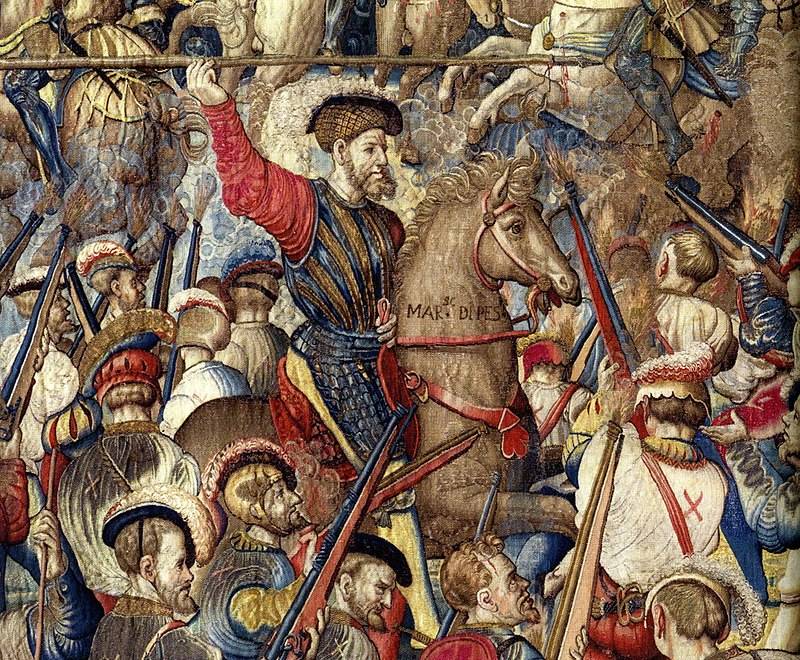
Francesco Ferdinando d'Avalos d'Aquino, 7th Marquis of Pescara, 3rd Marquis of Vasto (c. 1530–1571), commander-in-chief of the Spanish army in Lombardy and Piedmont, governor of Milan (1560–1571) is depicted with a spear in his hand. and Viceroy of Sicily (1568–1571)
"Some Germans" who, according to an early account of the battle, found Francis on the ground and wanted to kill him, but spared him after he screamed that he was King of France. Also, a certain Nicholas, Count of Salm, became a holder of the Order of the Golden Fleece for the capture of King Francis. The Italian condottiere Cesare Gercolani was awarded by Charles V as a “hero of Pavia”, but what else did he do besides kill a horse under Francis?
There are other individuals named in some reports. For example, Pedro de Valdivia, the future conqueror of Chile, who allegedly prevented another soldier from killing Francis, and two more French traitors, a follower of Charles de Bourbon, who allegedly convinced King Francis to surrender. The fact is that for many years Charles V himself honored different people for the capture of the king of France for some reason.
It is interesting that on July 24, 1529, Emperor Charles V issued a decree conferring a coat of arms on Alonso Pita da Veig for his deeds in the Battle of Pavia, which was archived in the General Archive of Simanske. In it, Charles V does not point to one person, but to a group of people, which included da Veiga: “... and in the same battle you (Alonso Pita da Veiga) did so much that you captured the said king (Francis I) along with other people."
Finally, in his autobiography, Charles V claimed that "the king was taken prisoner by his chief captains", thus paying tribute to the Duke of Bourbon, Charles de Lannoy and the Marquis of Pescara.
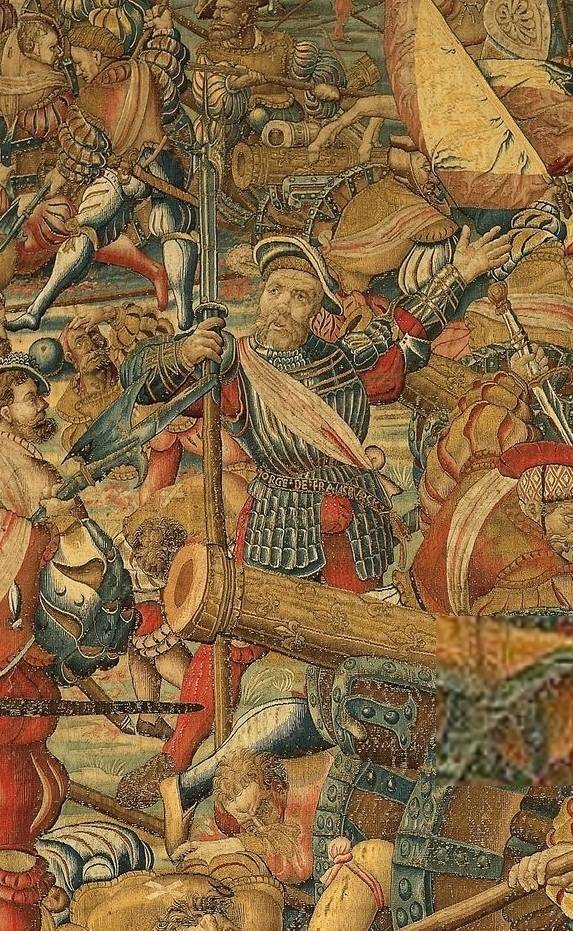
Captain of the German landsknecht Georg von Frundsberg
The main thing is that the defeat of the French was decisive.
In addition to Francis, many noble French nobles were captured, but many more were killed in battle. Francis was taken to the fortress of Pizzigetton, from where he wrote a letter of tragic content to his mother Louise of Savoy: “I am writing to inform you how the rest of my misfortune is proceeding. For me, everything is lost, except for honor and life, which is safe ... ”He had to remain imprisoned in Madrid until he signed the Treaty of Madrid. But then the Pope released him from the need to comply with it, and in 1526 a new Franco-Imperial war began ...
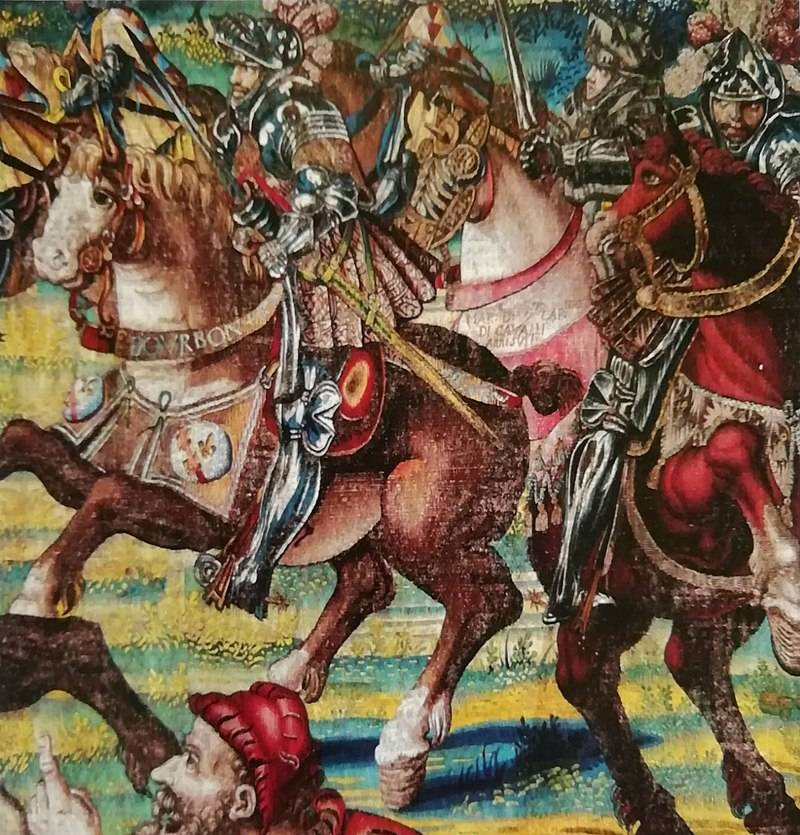
Captain General Charles III, Duke of Bourbon
The most unusual thing about all this is that the victory of Charles V at the Battle of Pavia was almost immediately immortalized in seven beautiful tapestries that tell about the various episodes of this battle.
The material for the tapestries was woolen and silk yarn, silver and gold threads, and all of them have amazing dimensions: from 8 to 9 m in length and about 4,3 m in height. The tapestries were woven between 1528 and 1531. in the workshop of Willem and Jan Dermoyen.
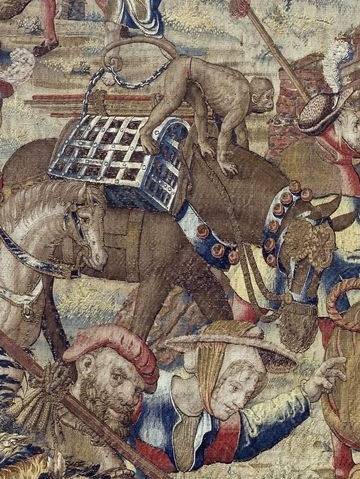
A very curious character in tapestry 5 is a monkey on a mule. And it would be nice if they portrayed her in a wagon train. So no - "goes on the attack" almost in the forefront. Or is it a mule that has loosened its leash and is running wherever its eyes look?
The sketches on cardboard were made by the painter Bernard van Orley (1488–1541), who drew them between 1525 and 1528. The Netherlands at that time were under the rule of Spain. Therefore, it is not surprising that the Estates General presented them as a gift to Charles V on March 2, 1531.
At first they were in the Imperial Collection of the Austrian Emperors, but then fell into the hands of the heirs of Fernando Francesco d'Avalos, Marquis di Pescara (1496–1525), condottiere and Spanish general, Viceroy of Sicily. He was not only a participant in the battle, but also one of its main heroes of the battle, and died from his wounds.
At the end of the XNUMXth century, the tapestries came into the collection of the National Museum of Capodimonte in Naples.
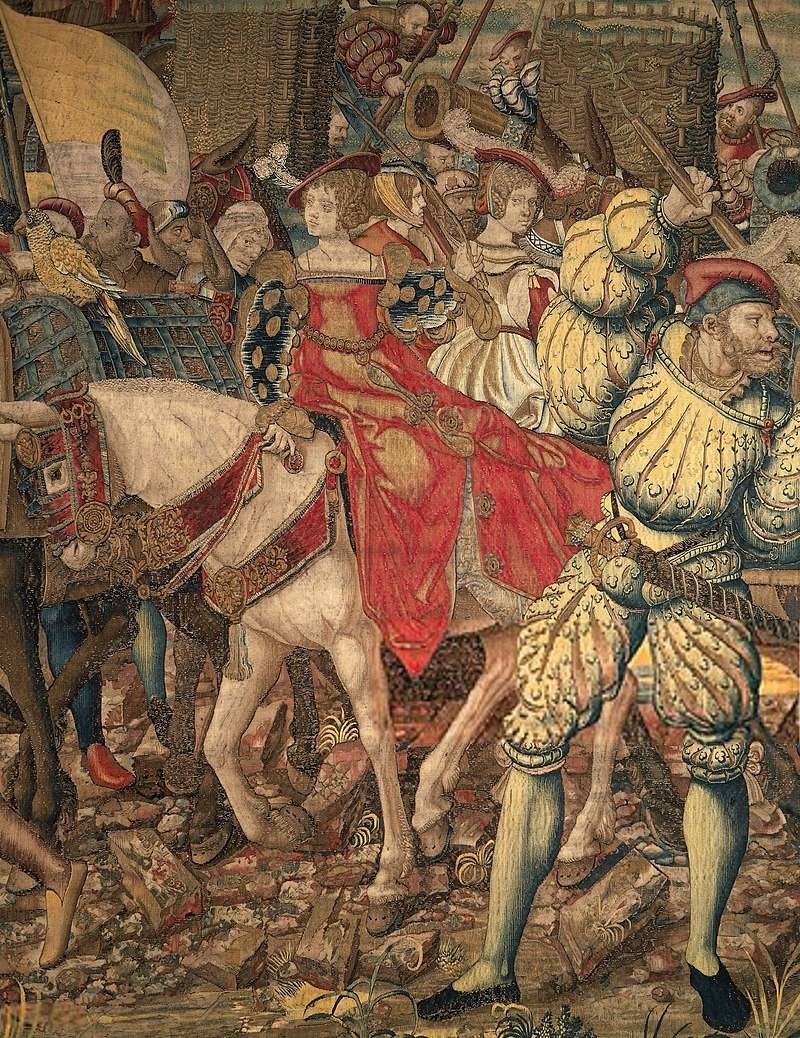
The mysterious lady in red. I wonder if at the time when the tapestry was created, did anyone know who she was? Or was it known only to the artist van Orley?
Information